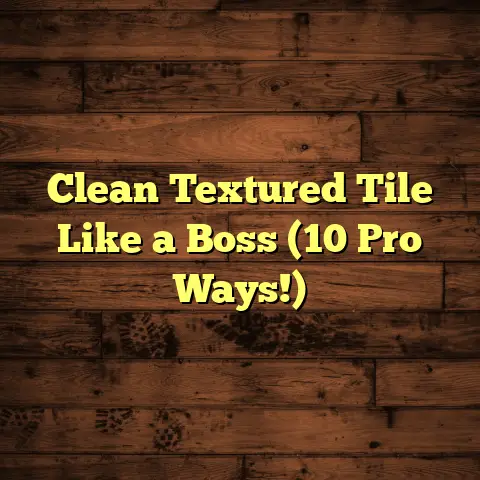Engineered Wood Care Tips: You Need These! (3 Fixes Now!)
In my years as a flooring contractor, I’ve seen it all.
Trends come and go, but one flooring option consistently wins hearts: engineered wood.
It’s a beautiful blend of natural charm and modern engineering, making it a favorite for many.
Engineered wood gives you that classic hardwood look without the hefty price tag or the installation headaches.
Plus, it’s more stable than solid wood, meaning it can handle humidity and temperature swings a bit better.
But, like any investment, it needs some TLC.
That’s why I’m sharing my insider tips to keep your engineered wood floors looking fantastic for years.
I’m going to walk you through three critical fixes that every engineered wood owner should know.
Trust me, a little maintenance goes a long way in preserving the beauty and longevity of your floors.
Let’s dive in!
Understanding Engineered Wood Flooring
What is Engineered Wood?
Okay, so what exactly is engineered wood?
Think of it as a multi-layered sandwich.
The top layer is a thin veneer of real hardwood, giving you that authentic wood look and feel.
Underneath, there are multiple layers of plywood or high-density fiberboard (HDF), bonded together.
This construction makes it more stable and less prone to warping compared to solid hardwood.
Engineered Wood vs. Solid Hardwood vs. Laminate:
| Feature | Engineered Wood | Solid Hardwood | Laminate |
|---|---|---|---|
| Composition | Hardwood veneer over core layers | Solid piece of wood | Photographic layer over composite core |
| Moisture Resistance | Better than solid hardwood | Susceptible to moisture | Varies, often water-resistant |
| Cost | Moderate | Higher | Lower |
| Installation | Easier, can be floated or glued down | More complex, typically nailed down | Easy, often click-lock |
| Refinishing | Limited, depends on veneer thickness | Multiple times | Not possible |
As you can see, engineered wood strikes a nice balance.
You get the real wood aesthetic with improved stability and often a more budget-friendly price point.
Advantages of Engineered Wood Flooring:
- Stability: Less prone to warping in humid environments.
- Cost-Effective: Generally more affordable than solid hardwood.
- Installation Versatility: Can be installed over various subfloors.
- Aesthetic Appeal: Offers the look and feel of real wood.
Common Issues Faced by Engineered Wood Owners
Now, let’s talk about the challenges.
Even with its advantages, engineered wood isn’t immune to problems. Here are some common issues I see:
- Scratches and Dents: Everyday wear and tear can leave its mark.
- Water Damage and Warping: Spills and high humidity can cause issues.
- Fading and Discoloration: Sunlight and cleaning products can affect the color.
Don’t worry, these issues are manageable!
With the right knowledge and a bit of elbow grease, you can keep your floors looking their best.
Fix #1 – Addressing Scratches and Dents
Identifying the Severity of the Damage
First things first: assess the damage.
Is it a minor surface scratch or a deeper gouge?
Run your hand over the area.
Can you feel the scratch, or is it just visible?
For minor scratches, you might only need a simple touch-up.
Deeper gouges, on the other hand, might require a bit more work.
Tools and Materials for Assessment:
- Good Lighting: To clearly see the scratches and dents.
- Magnifying Glass (Optional): To examine the damage closely.
- Notebook and Pen: To document the location and severity of each issue.
DIY Repair Techniques for Minor Scratches
Alright, let’s get our hands dirty!
For minor scratches, I often recommend these DIY fixes:
- Wood Filler or Wax Stick: Find a color that closely matches your floor. Apply it to the scratch, following the manufacturer’s instructions. I like using a plastic putty knife to smooth it out.
- Buffing Techniques: For very light scratches, a simple buffing can do the trick. Use a soft cloth and a bit of floor polish. Rub gently in the direction of the grain.
Pro Tip: Always test your repair technique in an inconspicuous area first!
You want to make sure the color matches and that you’re not causing any further damage.
Professional Repair Options for Deeper Dents
Sometimes, DIY just isn’t enough.
For deeper dents and gouges, it’s often best to call in a pro.
When to Consider Hiring a Professional:
- The damage is deep and affects multiple layers of the flooring.
- You’re uncomfortable working with power tools or chemicals.
- You want a seamless repair that blends perfectly with the surrounding floor.
Common Repair Methods Used by Professionals:
- Wood Patching: Replacing the damaged section with a new piece of wood.
- Color Matching and Staining: Ensuring the repair blends seamlessly.
- Refinishing (Partial or Full): Smoothing out imperfections and restoring the floor’s finish.
Fix #2 – Preventing and Repairing Water Damage
Understanding the Impact of Moisture on Engineered Wood
Water is the enemy of wood, plain and simple.
Even though engineered wood is more stable than solid hardwood, it’s still susceptible to water damage.
High humidity can cause the core layers to swell, leading to warping and buckling.
Spills, leaks, and even excessive mopping can also cause problems.
Signs of Water Damage to Look Out For:
- Cupping: The edges of the boards are higher than the center.
- Buckling: The boards are lifting or separating from the subfloor.
- Discoloration: Dark spots or stains on the surface of the wood.
- Mold or Mildew: A musty odor or visible growth.
Preventative Measures to Avoid Water Damage
Prevention is always better (and cheaper!) than cure.
Here are some steps you can take to protect your floors:
- Proper Installation Techniques: Make sure your floors are installed correctly. A vapor barrier is essential, especially in basements or over concrete slabs.
- Humidity Control: Maintain a consistent humidity level in your home. I recommend using a dehumidifier in humid climates and a humidifier in dry climates. The ideal humidity level for wood floors is between 30% and 50%.
- Regular Cleaning: Clean up spills immediately. Use a damp (not wet!) mop and a pH-neutral floor cleaner.
Pro Tip: Avoid steam mops on engineered wood!
The excessive moisture can penetrate the surface and cause damage.
Repairing Water-Damaged Engineered Wood
Okay, so you’ve got water damage. Now what?
The first step is to dry out the affected area as quickly as possible.
- Steps for Drying Out Affected Areas:
- Remove any standing water with towels or a wet/dry vacuum.
- Use fans and dehumidifiers to circulate air and remove moisture.
- If possible, lift the affected boards to allow them to dry from underneath.
- When to Replace Boards vs. When to Repair:
- If the damage is minor and the boards are still structurally sound, you may be able to repair them.
- If the boards are severely warped, buckled, or have mold growth, it’s best to replace them.
Replacing individual boards can be tricky, so I often recommend calling in a professional for this task.
Fix #3 – Combatting Fading and Discoloration
Factors Contributing to Fading
Sunlight is a double-edged sword.
It brings light and warmth into our homes, but it can also cause fading and discoloration of your engineered wood floors.
- The Role of Sunlight and UV Exposure:
- UV rays break down the pigments in the wood finish, causing it to fade over time.
- Areas that receive direct sunlight are most susceptible to fading.
- How Cleaning Products Can Affect Color:
- Harsh chemicals and abrasive cleaners can strip the finish and dull the color of your floors.
- Always use a pH-neutral floor cleaner specifically designed for engineered wood.
Preventative Strategies to Maintain Color Integrity
Here’s how to keep your floors looking vibrant:
- Use of Rugs and Window Treatments:
- Area rugs can protect your floors from direct sunlight in high-traffic areas.
- Window treatments like blinds, curtains, or UV-blocking film can filter out harmful UV rays.
- Choosing Finishes with UV Protection:
- When installing new floors, opt for a finish that contains UV inhibitors.
- These finishes help to block UV rays and prevent fading.
Restoring Faded Floors
If your floors have already started to fade, don’t despair!
There are ways to restore their color:
- Techniques for Refinishing Engineered Wood:
- Light sanding to remove the faded finish.
- Applying a new stain or finish with UV protection.
- When to Consider Professional Refinishing Services:
- Refinishing engineered wood can be tricky because of the thin veneer layer.
- It’s often best to hire a professional to ensure the job is done correctly and to avoid damaging the floors.
Important Note: Not all engineered wood floors can be refinished.
It depends on the thickness of the veneer layer.
Consult with a flooring professional to determine if your floors are suitable for refinishing.
The Lasting Beauty of Well-Maintained Engineered Wood
So there you have it: my top tips for keeping your engineered wood floors looking their best.
By addressing scratches and dents, preventing water damage, and combating fading, you can ensure that your floors remain a beautiful and lasting foundation for your home.
Remember, a little bit of care goes a long way.
Embrace the beauty of your floors, and with these tips in hand, you’ll enjoy their charm for years to come!
Happy flooring!





